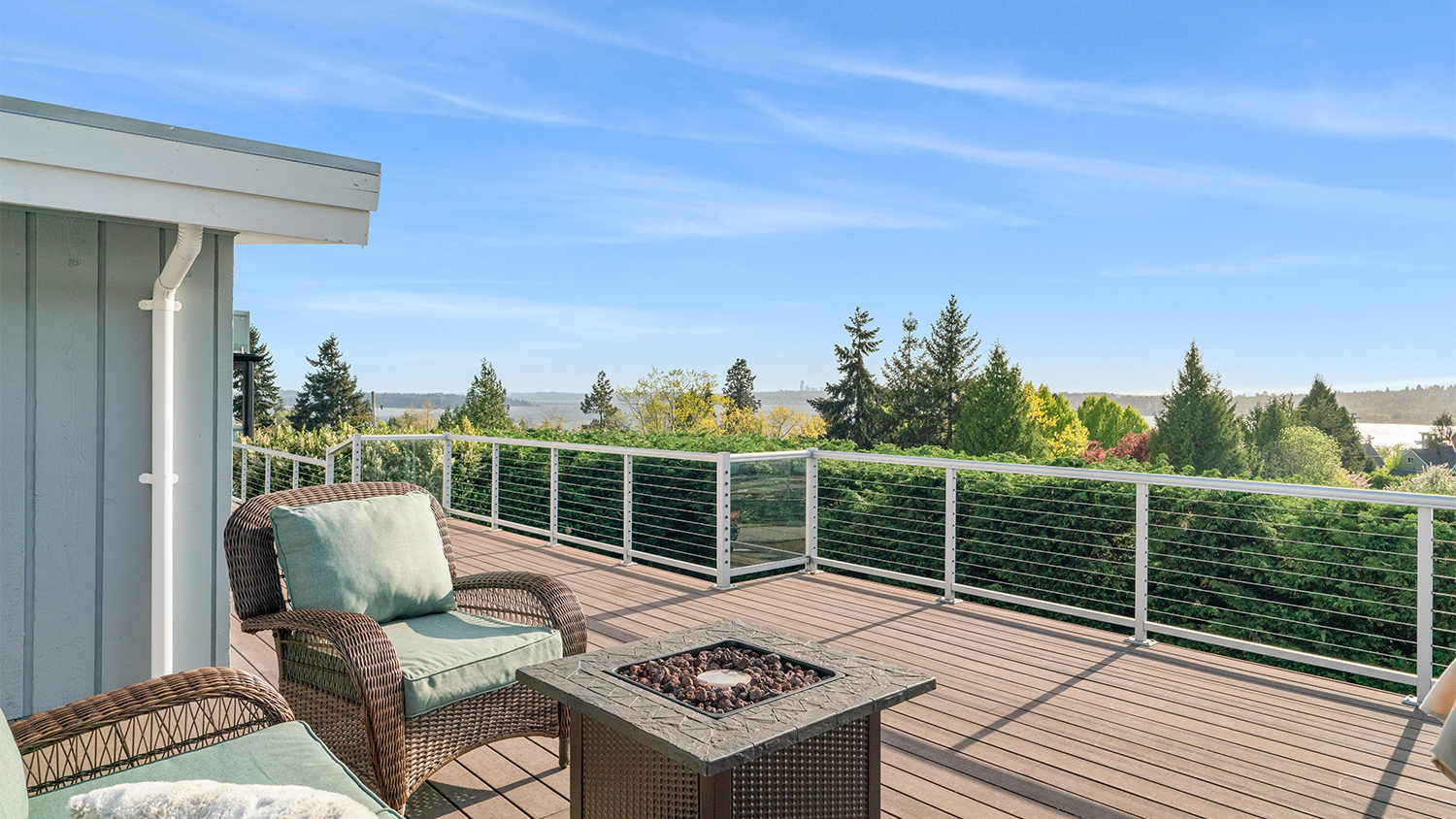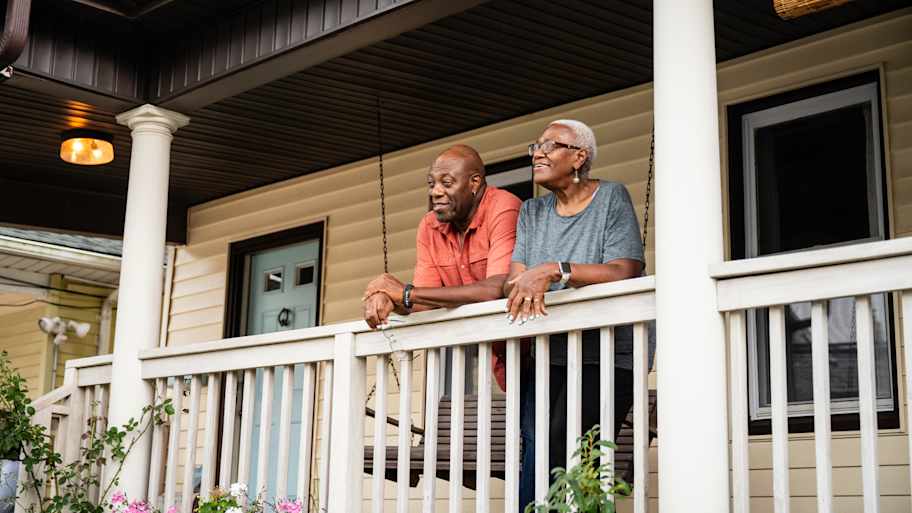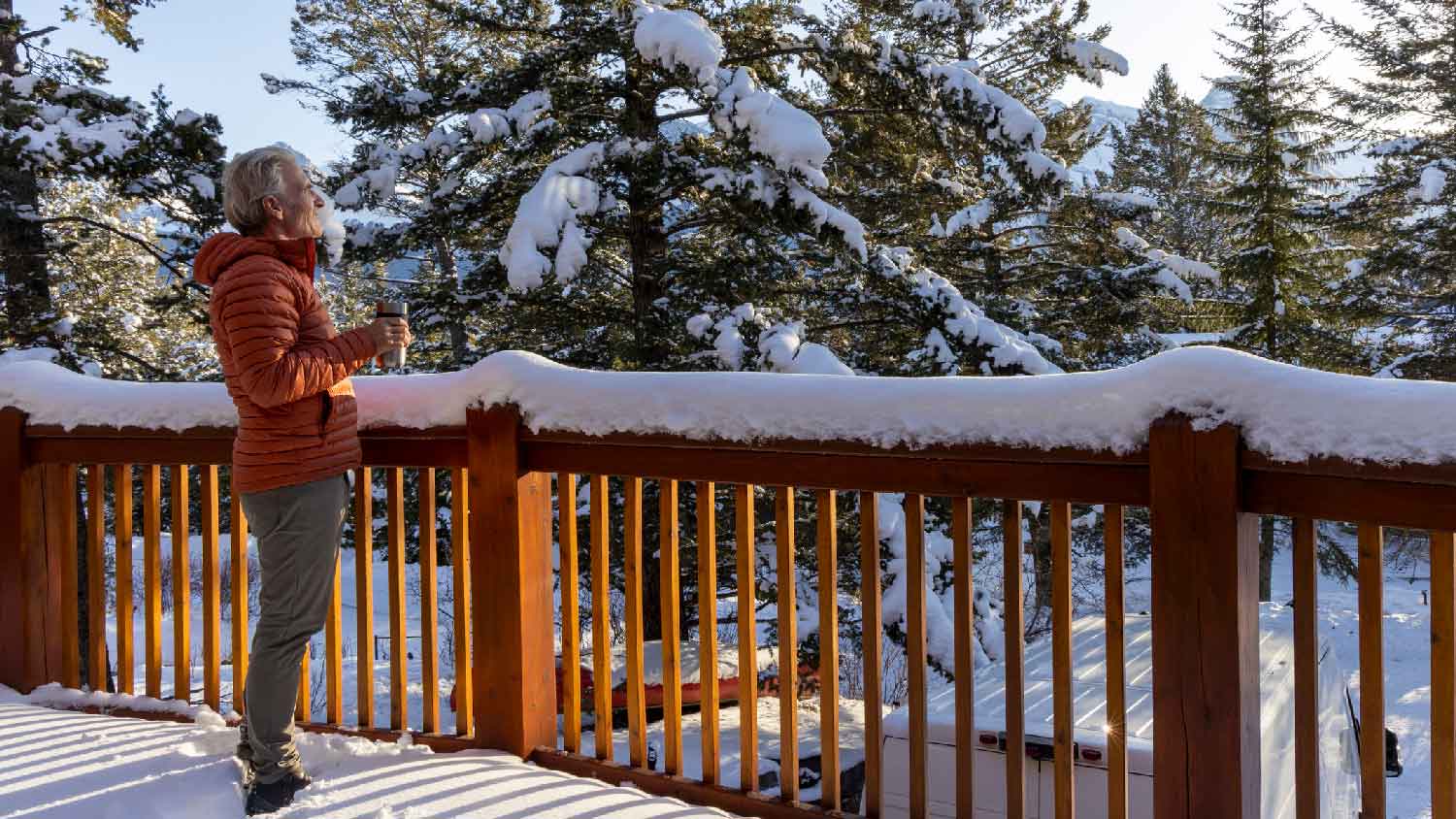Deck replacement costs depend on materials, any structural damage you need to fix, and more. This guide explores how much it costs to replace or repair a deck.
What’s the Difference Between Cable Railings and Glass Railings?
Make the most of the view from your deck with new, modern railings
Both styles are well-suited for modern deck designs.
Cable railings are more affordable and easier to maintain.
Glass railings are safer and offer completely unobstructed views.
Cost per linear foot is $150–$250 for cable and $200–$450 for glass.
Your deck or balcony is your view to the outside world, and you want to maximize your view while keeping safety in mind. With the wide variety of deck railing options available, it can be difficult to decide which is right for your home. If you’re looking to build or update a deck, modern railings can complete and enhance the look you’re trying to achieve. This guide will help you compare cable railings vs. glass railings, so you can decide which will best meet your needs, style, and budget.
Cable Railing vs. Glass Railing: Key Differences
Cable railings and glass railings are both great options for your deck or balcony, but they differ in a few key ways that may make it easier for you to decide which one to use. Cable railings are made of durable steel cables that require little maintenance and provide a budget-friendly option. Glass railings allow an unobstructed view, and offer security for households with kids or pets.
What Is a Cable Railing?

Cable deck railing comprises a series of posts with stainless steel cables threaded through horizontally. The other standard cable railing construction has a top and bottom rail and vertical cables.
| Pros | Cons |
|---|---|
| Durable | Potential safety risk |
| Minimal maintenance | May not meet building codes |
| More affordable than glass railings | Pricier than wooden railings |
Best for:
Households without small children or pets
Budget-conscious homeowners
Those looking for low-maintenance railings
Pros
Durable stainless steel cables resist corrosion and grime buildup.
Minimalist, open-style blends into the background for an unobstructed view.
Easy maintenance requires occasional tightening with a wrench.
Cables cover long distances and are more affordable than glass panels.
Available in a variety of finishes ranging from shiny to dark metals.
Nature-friendly design doesn’t harm flying birds.
Adds value to your home with versatility and durability.
Cons
Open space between cables and the ladder-like design may be a safety risk.
Might not meet local building codes in some cities or areas.
More expensive up front than wood railings.
What Is a Glass Railing?
Glass panels also offer a sleek, modern appearance for deck railings. These framed or frameless panels are frequently clamped between posts with glass clips and offer a practically invisible appearance.
| Pros | Cons |
|---|---|
| Unobstructed views | Require frequent cleaning |
| Safer for kids and pets | Can be hazardous to birds |
| Available in a range of styles | More expensive |
Best for:
Households with pets or small children
Those who want a fully unobstructed view
Homeowners who don’t mind more frequent maintenance
Pros
Made from highly durable material that stands up to harsh weather.
Transparent glass allows unobstructed outdoor views, even from low vantage points like lounge chairs.
More coverage accounts for small children and pet safety considerations.
Quarter-inch thick tempered glass provides good security.
Available in a range of decorative options and color tints.
Cons
Requires thorough and frequent cleaning.
Subject to grime and mineral stains if not properly maintained.
Transparent panels can be a hazard to flying birds.
Tend to be more expensive than most other deck rail materials.
Cable Railings vs. Glass Railings
Both railing options open up outdoor spaces and provide better views. Despite these similarities, some obvious differences may sway you one way or the other when making a selection. We’ll compare these two contemporary railing materials below across various categories.

Appearance: Tie
Both cable and glass railings create a modern or contemporary design that may not work for more traditional decks. They tend to look best with stainless steel frames or a mixture of wood and metal or composite materials for a clean, functional appearance.
Both railing types offer some versatility—like glass color tints or different cable orientations— and can be used to create a more open, spacious feel. Otherwise, their similarities mean that appearance comes down to your personal preference.
Durability: Cable Railings
These modern railing materials are both designed with durability in mind. Cable railings have stainless steel cables and posts and can withstand harsh sunlight and marine environments for many years.
Glass railings, meanwhile, are made using quarter-inch thick panels of tempered glass that is also virtually indestructible in harsh weather. However, glass is still susceptible to chipping or scratches, and some cleaners can cause damage that’s expensive to remove.
Price: Cable Railings
Cable deck railings are expensive compared to the cost of other deck railing materials but tend to be more affordable than glass. Deck railing installation costs range from $200 to $450 per linear foot for glass railings and $150 to $250 per linear foot for cable railings.
The cost of cable railings will increase and become similar to glass if you opt for all stainless steel cable railings. You can save on cable railings by choosing wood posts and framing.
Maintenance: Cable Railings
Cable rails require almost no maintenance. The materials used to build them are resistant to corrosion and damage from harsh weather, even near the ocean, where salty air is typically an issue. Because the cables need tension to stay firm and create a safe barrier, you will occasionally need to tighten them with a wrench when they get loose. A local deck repair company can help with more extensive repairs if necessary.
Glass panels require much more extensive maintenance. They can be difficult to keep clean, especially if your deck is elevated. A common problem is the buildup of unsightly grime, and you’ll need to use glass-safe cleaners and regularly clean to avoid lasting damage.
View: Tie
Newly installed glass railings offer completely unobstructed views thanks to their transparent design. However, without proper cleaning, they are prone to water stains, smudges, dirt, and grime that can distort your view and be hard to remove, especially if you have an elevated deck.
Cable railing may not be as transparent, but it is designed to be thin enough so that your eyesight can focus beyond the railing. Your only true obstructions are the posts and top railing.
Safety: Glass Railings
Properly installed and maintained cable railings are rigid and spaced about four inches apart. This creates a barrier that should effectively block large objects from falling through. However, openings are still present, and horizontal cables can also create a ladder-like appearance.
Glass rails, on the other hand, are slick surfaces with little to no space in between. If safety for small children or pets is a top priority for your home, glass may be a better fit.
Eco-Friendly: Cable Railings
These sturdy modern materials both last for years and won’t need to be replaced often, so they don’t end up in landfills as often as some of their less-durable counterparts. However, glass railings do pose one environmental issue. Because they’re transparent, flying birds won’t always see them in time to avoid a collision. The spaces between cable railings are much more bird-friendly.
The homeowners guide to deck and porch services
From average costs to expert advice, get all the answers you need to get your job done.

Are your porch columns old or simply unsightly? It might be time to refresh them. Here's a breakdown of the cost of replacing porch columns.
Deck repair costs depend on materials, damage you need to fix, and more. See how much it costs to replace or repair a deck in Columbus, OH.

Dreaming of an outdoor area for relaxation, but not sure how big to go? Learn about standard porch sizes and how to set proper dimensions.

Learning how to winterize a deck can protect your outdoor space from harsh weather. Here’s how to do it properly so you can enjoy a fresh deck next summer.

Your deck railings help prevent injuries, but only if they’re the proper height. Discover the ideal deck railing height to ensure your safety and compliance with building codes.

